PATAN THE CITY OF ARTIST: | ||||||||||||||
Patan, the historic city is also termed as the City of Fine Arts, which is rich in culture, crafts having thousand years of history. It is considered as one of the ancient cities, having full of Hindu temples as well as Buddhist monuments where all ethnic communities belonging to both Hinduism and Buddhism have embraced each other in harmony .and peace. The city is, just 5km south east to the Capital city Katmandu. The city spreads over 16 sq. kilometers and divides into 22 Municipal wards and is inhabited by roughly 165,000 people. Newars, the indigenous inhabitants of Patan, have their own unique culture and traditions which is also recognized as a cultural resource of the world. One of Patan’s biggest festivals, the Machhendra nath jatra, a unique chariot festival celebrated for a month in May-June. A substantial portion of the population is engaged in various trades, especially in traditional handicrafts and small scale cottage industries and the rest are busy in agriculture The city is said to be designed in the shape of the Buddhist Dharma-Chakra (Wheel of Righteousness). It is also famous for its narrow streets and alleys, lined by traditional buildings, unique stone water conduits and vernacular architecture, Hindu and Buddhist monuments. There are more than 1,200 Buddhist monasteries and monuments of various shapes and sizes scattered in and around the city. The most important monument of the city is the medieval palace complex, Patan Durbar Square,
| ||||||||||||||
| ||||||||||||||
Golden Temple: THE FOUR STUPAS OF ASHOKA: The most remarkable feature of the town of Patan is its four ancient architectural Ashoka Stupas. There are four 'thurs' or mounds located on the perimeter of Patan, one at each cardinal point and are popularly known as the Ashoka Stupas. . Legendary Ashoka, Mauryan Emperor of India, Calong his daughter Charumati visited Kathmandu in 250 B. and erected these Stupas. The historians have agreed that these Stupas might have been erected in connection with the foundation of Patan towards the end of the 4th century AD. Lagan Thura: Teta thura: Pucho Thura: Ibhahi Thura: | ||||||||||||||
Tuesday, December 25, 2012
PATAN THE CITY OF ARTIST:
Monday, December 24, 2012
Shri Swaminarayan Mandir
 An image of the under construction marble temple | |
| Name | |
|---|---|
| Location | |
| Location: | Bhuj |
| Architecture and culture | |
| Primary deity: | Nar Narayan |
| History | |
| Date built: | Expected: May 23, 2010 |
Shri Swaminarayan Mandir, Bhuj is a new temple complex coming up in Bhuj. It is a
Swaminarayan temple that will come under the Nar Narayan Dev Gadi of the Swaminarayan Sampraday. The opening ceremony of the temple is scheduled to take place between May 15 and May 23, 2010.[1]
An Earthquake on 26 January 2001 shattered most parts of the city of Bhuj (Kutch District), including the original Shri Swaminarayan Mandir, Bhuj built by Bhagwan Swaminarayan in 1824. To replace this, the new temple is being built of only marble and gold. The throne for the idol of Swaminarayan, the temple domes and doors will be of gold whiles the pillars and ceilings will be made of marble.[1] The original central deity images of Nar Narayan and Swaminarayan in the form of Hari Krishna will be moved from the old temple to the new one along with those of Radha Krishna, Swaminarayan in the form of Ghanshyam and Sukh Shaiya and others.[2]
The new temple is being built at a cost of 1 billion Indian rupees (100 crore) on 5 acres (20,000 m2) of land. Made in marbe, intricate carvings adorn the pillars and ceiling of the most expensive temple to be built in the Indian state of Gujarat recently.[3]
A large number of people are expected to attend the opening ceremony of the temple including a people from overseas, including from United Kingdom and various parts of Africa. According to an estimate by a member of the Bhuj Hoteliers' Association, as of October 2009, 75% of the hotel rooms in Bhuj had been booked for the period during which the opening ceremony is scheduled to take place.[1] To manage influx of vehicles, Jubilee ground and Khasda ground, the two biggest grounds in Bhuj will be used for parking arrangements.[1] Temple authorities are expecting around 500,000 (5 lakh) visitors during this period.[3]
A 3D film, the first of its kind on the life and teachings of Swaminarayan titled 'Sahajanand' will be screened as part of the opening celebrations of the temple. Shot by S3D cameras, it is claimed to be the first of its kind in India.[4]
Koteshwar Temple
| ||||||||||||
|
Sunday, December 23, 2012
TEEN DARWAJA
| TEEN DARWAJA |
Gujjaratta,
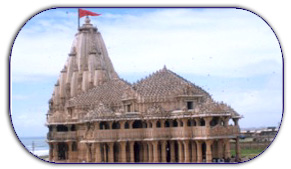
There is no denying the fact that people all over the world have an irresistible urge to know about Gujarat - its history and culture. Enclosed by Pakistan and the states of Rajasthan to the north eastern part of the country, Madhya Pradesh to the east and Maharashtra and the Union territories of Diu, Daman, Dadra and Nagar Haveli to the south, Gujarat is one of the prime tourist destinations in India. A seat for deep seated folk and classical cultures, the state reflects a rich heritage of the country’s past.
Trying to know more and more about Gujarat will lead you to explore avenues more than you actually expected. Walks along the beautiful Diu Beach, Ahmedpur Mandvi Beach, or visits to the various temples which are some of the finest tourist attractions in India will offer some of the memorable moments of your life. The Rann of Kutch which occupies a large area of western Gujarat is famous for its rare ecosystem, wildlife, fossils, and terrain.
Fast Facts
| Area | 1,96,024 sq km |
| Population | 41,309,582 |
| Religion | Hinduism (89.48%), Islam (8.73%), Others (1.79%) |
| Maximum Temperature | 42°C |
| Minimum Temperature | 14°C |
| Capital | Gandhinagar |
| Languages | Gujarati, Hindi, English |
| Best Time To Visit | October to March |
History
Having derived its name from Gujjaratta, meaning the land of the Gujjars, a tribe which migrated to India around the 5th century AD, Gujarat has its history dating back to many Indus Valley and Harappan centers that have been discovered in the states like Rangpur, Lothal, Lakhabaval, Dholavira, Amri, and Rozdi. Gradually with the advent of the Yadava tribe led by Lord Krishna, some 3,500 years ago, Gujarat reached its most glorious days.
History about Gujarat says that Ashoka, the Mauryan king extended his kingdom to Gujarat. The downfall of the Maurya Empire subsequently led the smaller kingdoms to establish their authority in this state. The state prospered greatly during the time of Solankis from the 9th century. In the 12th century AD, Allauddin Khilji, the Sultan of Delhi defeated the Waghela king of Gujarat and a long era of Muslims started. Power changed hands to the Marathas and ended the Muslim rule in the 18th century only to be further transferred to the British in the early 19th century. The East India Company set up its first center in Surat.
Gujarat was initially a part of Mumbai state till 1960; and Gujarat’s people decided to have their state divided on the basis of language and culture. This led to creation of the two new states of Gujarat and Maharashtra.
Saturday, December 22, 2012
SHAH ALAM ROZA
SHAH ALAM ROZA |
|
THE POLS
| THE POLS |
SARKHEJ ROZA
SARKHEJ ROZA |
|
Friday, December 21, 2012
JUMMA MASJID
| JUMMA MASJID |
ADALAJ STEP WELL
ADALAJ STEP WELL |
|
Thursday, December 20, 2012
GANDHI ASHRAM
| GANDHI ASHRAM |
King Karandev
King Karandev 1, the Solanki Ruler, had waged a war against the Bhil king of Ashapall. After his victory Karandev established the city called "Karnavati". In 1411 Sultan Ahmed Shah conquered Karnavati and after his name Karnavati was renamed to Ahmedabad. The city was built in open and spacious plane to the East of Sabarmati. It compromised of smaller known Fort as Bhadra Fort. The city fort wall was enclosed containing 12 Gates. |
|
Sunday, June 17, 2012
Bahucharaji Temple
Bahucharaji टेम्पले

Bahucharaji - Mother Goddess
Yet another Shakti tirth of Gujarat is the temple of Bahucharaji. People bring their children for the 'mundan' ceremony of their children. It is an ancient sacred site and features prominently among the' garb a - garbi' compositions in folk songs. Its older temple is 5 km away and it is quite ordinary too. But this one is very huge and grand. Its compound is also vast. On several occasions this is filled with thousands of devotees. In front of the temple is one Havankund and behind it is the home of Vallabh Bhatt Mevada who has composed a number of songs of garbis and garbas addressing the Mother Goddess. Next to the temple is Mansarovar Lake and a number of Dharmshalas for devotees and visitors.
Bahucharaji Mata is held in great honor in Gujarat. Among the most worthy places for visit near the ancient capital of Patan is this temple of Bahucharaji Mata. On full moon day of Chaitra and Aso months every year big fairs are held here. Folk dances and dramas of 'Bhavai' are also performed. The construction of this temple began in VS 1835 and it was completed in VS 1837 when the image of the Mother Goddess was ceremoniously installed.
Around this large area of the temple a fort is constructed, with four 'burj' and three Gates. This temple is ISm long and 9m wide. It has a dome and a shikhar. There is a great Mandapa facing the Garbhagriha. In the dome of this Mandapa or hall, on its pillars are painted dolls. Near the temple is one Havan or Agni kund for religious ceremonies. The open ground of the temple is popularly called 'chachar no chowk'. Near the gate of the temple is Mansarovar. On full moon day of Chaitra and Aso months people visit the temple in large numbers. The 'palkhi' procession of the Goddess is taken out to Shankhalpur. Many families come to the temple for the 'mundan' ceremony of their children when their hair is totally removed for the first time after birth as one of the 'sanskaras'.
Saturday, June 16, 2012
Siddhapur - Rudra Mahal
As we move upwards from the banks of Saraswati at the historic Anhilwad Patan, we come to Siddhapur. Just as Gaya is called the best place to hold the Shradda Sanskar for one's father, Siddhpur has the honor for similar rite for one's mother. It is said that Bhagvan Parshuram had performed this rite for his Mother and since then it has acquires this sacred aura for the later generations. Thus we find that even today this significance draws thousands for this rite here.
As we read the description of Rudra Mahal in treatises of the past, we find that this 'Mahalay' was true to its name a great and vast structure, with incomparable wealth of sculptured beauty. Mularaj of the Solanki dynasty had begun to construct it and Siddhraj Jaysinh completed it. When we read the grand narration about how it contained vast public halls, other big and small halls, stories and stories full of balconies and verandahs, with richly carved pillars and other sculpted beauties, and how thousands of Brahmans chanted Mantras for worship and uttered various Stotras, we feel that it was like another Somnath temple
However, Allauddin Khilji razed it to the grounds. Gradually it almost disappeared. Today we can see only four pillars with an arch. But even these little ruins can provide us an idea about the beauty and grandeur of the original structure. In a 100 m. by 75 m wide area, it was a structure of two to three stories, with 1600 pillars and a large public meeting hall (Sabha Mandap).
We also must take a note of the legend of Rudra Mahal about the laying of the foundation of this structure. When King Mularaj Solanki dreamt of making a grand Shiv-Rudra Mahalay on the banks of River Saraswati, he summoned the famous architect Prandhar, he invited many other architects and astrologers, besides the skilled arti.sans from far and near. These experts selected the stone for the construction and began their work
After Mularaj, the great architect Prandhar also died. Then came the great successors like Bhimdev: Kamadev and even the queen Minaldevi. On the throne of Patan now came Bhattark Siddharaj Jaysinh. Someone reminded him of the great dream of his ancestor Mularaj that was still incomplete. Siddharaj now took up the bid to complete that dream
He invited Markand Shastri from Malva, a great astrologer. Under his guidance a new place for laying the foundation of Rudra Mahal was undertaken. As the ceremony was being conducted the Shastri went on instructing. He said, 'Dig here for another yard and a little more. This is the 'Siddha Ghatika, the Honored Hour. Keep your eye on the stick held here and as soon as I call out, plant this gold nail into the ground." And at the auspicious second, under Markand shastri's instruction, this was done.
Markand Shastri was jubilant, "Dhanya, this is great fortune for everyone! 0 King, now nothing, not even TIME can touch this Rudra Mahalay, it would last until the Sun and the Moon last (Yavacchandradivakarau). Maharaj, the nail has been placed into the head of the Sheshanaga, One who holds the Earth on His head. Now this is a moment in time that does not move. It has no Beginning and no End.
The King Jaysinh respectfully bowed to him and said, "Acharyavar, even Lord Brahma has not made any Creation that has no End
Markandji replied, "Maharaj, according to my astrological calculations the auspicious time cannot go wrong. Even if the Pralay or the End of the World comes, it would only bow and touch the feet of this Mahalaya."
Jaysinh, "Oh! What End of the World, Gurudev? What head of Sheshnaga? -Just where is the Head that holds the Earth deep down, and look at the 1 Y2 inch of this little gold nail that went ointo it!! Guruji, say something that we can believe! Or, prove it at least
Markandji was upset, "0 King! Do not mock or test such things of Knowledge!"
Jaysinh haughtily replied, "Acharyaji! I too want to see the proof. Can you show it to me?"
Markandji said, "Maharaj! Well, take off the nail, and you will find blood flowing out! Just see for yourself!"
After a lot of discussion if such a step must be taken or not, as the King did not abandon his stance of doubt, Markand shastri agreed for pulling the nail out, "As soon as the nail is pulled, it should be pushed back once more." He directed.
The nail was pulled and just as it was being pushed back, the clothes of Jaisinh were sprayed with blood. The nail was pushed back once more. With absolute amazement and happiness, Jaisinh looked at Markand shastri. But Mrakandji was most unhappy. He said, "Maharaj, within the few moment of pulling and pushing back the nail, Sheshanaga has shifted. Now the nail has not struck his head but his tail!!"
Jaisinh asked, "So? What does that mean?"
Markandji said, "Adhishwar! I am unhappy to say that the result of this is that since you are sprayed with the blood of Sheshanaga, you would be invincible. However. ..
Jaishinh asked, "However ... ?"
Markandji continued, "However ... it means that your name and fame would suffer, and while Rudramahal would be completed, it also would be razed in time. The ringing of bells day and night would stop one day, each of its stone would be broken up with a hammer, its grandeur and significance lost in time. Only some ruins would tell us of its grandeur .... "
Thid may only be a legend, bu is indeed very intersting. When we recall it as we stand near the remnants of Rudramahal, we experience agreat thrill.
Miradatar:

Apart from the lain places of pilgrimage, to the n0l1h of Mehsana near Unjha and Unava is the sacred place for the Muslims called Muiradatar. However, here not just the Muslims but the Hindus also come for worship and offerings. All communities join its Fairs held regularly
Friday, June 15, 2012
The Haveli At Siddhapur
Garden Palace Balasinor
| [Reservation] | ||
|
Palace Utelia Gujarat
| [Utelia] [Reservation] | ||||
Accommodation: A total of 14 double bedrooms have been renovated to match the grandeur of the building and feature attached baths with running hot-and-cold showers, and dressing space. Some of the beds are real period pieces inlaid with mirrors and ornate decorations. Each of the rooms open onto private balconies or common verandahs with splendid views of the River Bhugavo where demoiselle and common cranes gather. Even if you are not staying here, it is worth dropping in for lunch on the way to Ahmedabad and Bhavnagar or Palitana. |
Thursday, June 14, 2012
Kumbhalgarh Fort
Kumbhalgarh Fort : Located 64 kms north of Udaipur in the wilderness, Kumbhalgarh is the second most important citadel after Chittorgarh in the Mewar region. Cradled in the Aravali Ranges the fort was built in the 15th century by Rana Kumbha. Because of its inaccessibility and hostile topography the fort had remained un-conquered. It also served the rulers of Mewar as a refuge in times of strife. The fort also served as refuge to the baby king Udai of Mewar. It is also of sentimental significance as it is the birthplace of Mewar's legendary King Maharana Partap.
The fort is self-contained and has within its amalgam almost everything to withstand a long siege. The fort fell only once that too to the combined armies of Mughal and of Amber for scarcity of drinking water. Many magnificent palaces an array of temples built by the Mauryas of which the most picturesque place is the Badal Mahal or the palace of the clouds. The fort also offers a superb birds view of the surroundings. The fort's thick wall stretches some 36 kms and is wide enough to take eight horses abreast. Maharana Fateh Singh renovated the fort in the 19th century. The fort's large compound has very interesting ruins and the walk around it can be very rewarding.
Ranakpur - Introduction
|
Wednesday, June 13, 2012
Gandhi Museum
Gandhi Museum |
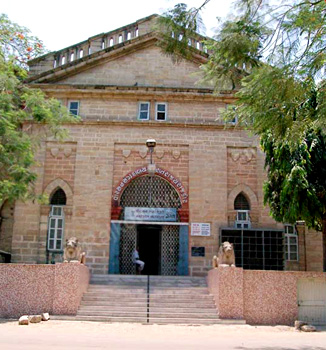
The Gandhi Museum is virtually a living testimonial to the Indian Legend in true sense, Mahatma Gandhi. He selflessly devoted his entire life to the struggle for independence and his doctrine on "Ahimsa" or Non-Violence is still reckoned to be the most lethal weapon that can demoralize and finally compel the foe to give up without a single drop of blood-shed. Mahatma Gandhi will always be an icon for the youth and live in our hearts through his immortal beliefs and wide-spread love and warmth. He is that person who virtually changed India's destiny single-handedly and sowed the seeds of brotherhood and peace which have bloomed into independent and secular India.
The Gandhi Museum has been erected in order to commemorate this great human being and inspire the coming generation to continue the fight against evil keeping in mind, 'Ahimsa', or Non-Violence.
Special Attractions
:- Extremely uncommon snaps that portray memorable moments of Gandhiji's life's are displayed in Gandhi Museum. The visitors through viewing these priceless moments of the legend himself on film can relate themselves with him and realize that he was not so different from us, but it was his sheer will-power and courage that helped him to succeed in his endeavor to free India.
- The Gandhi Museum also houses many letters, other documents and other possessions of "The Father of the Nation".
- There is also ample scope for prayers, documentary movies, recordings made from his lectures for the visitors.
- The address of Gandhi Museum in Gujarat is :-
Gandhi Smriti
Bhavnagar 364001
Shanku's Water World Resort Mehsana
| [Mehsa na] | |||||
|
Tuesday, June 12, 2012
Baroda Museum and Picture Gallery
Baroda Museum and Picture Gallery |
Maharaja Sayajirao Gaekwad, a charismatic icon to many, laid the foundation of the Baroda Museum and Picture Gallery in the year 1887. The Baroda Museum and Picture Gallery is well-endowed with a vast array of spectacular and extremely rare antiquities that has presented it with a completely new dimension and has also earned it immense respect and gratitude on a global scale.
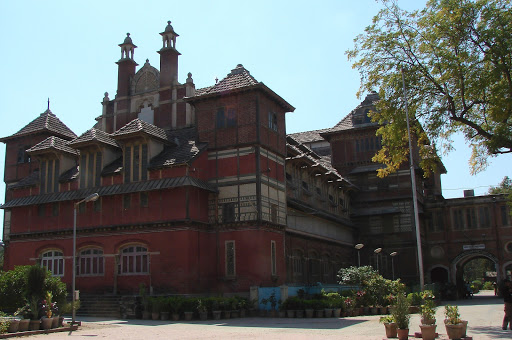
Today, the Baroda Museum and Picture Gallery is recognized as one of the most sought after museums located in the eastern realm of India.
The Baroda Museum and Picture Gallery comprises of two separate buildings that possesses a meek exuberance of Indo-Saracenic engineering. Majority of the coveted articles residing in the Baroda Museum and Picture Gallery of Gujarat was personally accrued by Maharaja Sayajirao Gaekwad.
It was the sheer aspiration of two men which laid down the corner stone of this legendary mansion. They were RF Chisholm and Major RN Ment whose architectural magnificence gave shape to the Baroda Museum and Picture Gallery of Gujarat.
Special Attractions
- Graeco-Roman gallery
- European Roman, 7th-18th centuries AD (pre-industrial period) and 8th-20th centuries AD
- Unique exhibition Vestibule
- Library armed with many books.
- Store, Civilizations and Arts of Asia
- Japanese Gallery
- Tibetan and Nepalese Gallery
- Egyptian along with Babylonian Gallery
- Gallery dedicated to Chinese artifacts.
- Islamic Gallery containing pictures descending from Persia, Iraq, Turkey, Syria, Egypt, Spain, etc.
- Baroda room (Depicting Gujarati and Maratha artforms)
- Indian art gallery.
- Central Vestibule (Baroda state history)
- Prehistoric room and a section featuring Archaeological specimens
Picture Gallery contains pictures of the following
- Modern Indian picture gallery, natural history room
- Zoology, Paleontology and Ethnology
- Mineralogy, petrology, geology
Calico Museum of Textiles
Calico Museum of Textiles |
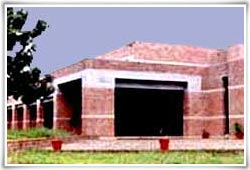
The Calico Museum of Textiles came into existence in 1949 and was the inspiration of Ms.Gira Sarabhai.
Main Attractions
- The Calico Museum of Textiles exhibits two groups of 'pichhwais' first of which depicts scenes from sarada purnima, Govardhana, Dharana, Gopastami, Ramanavami and Nandamahotsava. The other group of Pichhwais deals with seasonal themes like 'grisma', 'varsa', 'sarada' etc.
- The 'Parsvantha' built out of bronze belonging to 1235 AD., a sand-stone-replica of the 12th century AD, embodiment of Tirthankara Digambara, another bronze statuette of 'Dvitirthi' dated back to the 7th century.
- Ancient holographs that are created on palm leaves belonging to the Jainas are carefully preserved here like the 'Kalpasutra' that was further divided into three parts - Jinacharita, Samachari and Sthaviravali.
- Adhai Dvipi Pata, Jnana Baji Pata are really ancient piece of embroidery that are on exhibit in the Calico Museum of Textiles at Gujarat.
- Apart from religious textile articles there are also some exquisite carpets that are speculated to have descended from the workshop conducted by the Great Mughal emperor, Akbar and have a taste of Persian skills.
- Mughal war protection attires includes Helmets, chain mall, shields in the shape of a rhinoceros, swords, etc.
- 15th century Indian textiles associated with trade, silk weaving, 'patolas', patalu shawls, scarves, Sadi belonging to the 19th century, etc.
Monday, June 11, 2012
Dadar Nagar Haveli
Small is beautiful and so is Dadra & Nagar Haveli, It is love at first sight. The tall awesome trees, the rivers flowing past them, the green grass mingling with fields of darker green, and the distant hills dotting gently rolling hills. Whether it is the summer, which dries the land, or the southwest monsoon whipping the wind-swept trees and turning the land into an endless stretch of green, it won’t matter. You’ll love the serene and the calm land of Dadra & Nagar Haveli.

Many hands have ruled this quiet magical land of 72 villages. And the memory of these rulers still lingers on, for a century and a half, the fiery Portuguese were the masters of the land. When the land was liberated from their rule, it was taken over by the locals until it merged with the Indian Union. As a land it is not very large, only 491 sq. Kms. is covered with forests and woods, a heaven for the simple, colourful tribal folks. But as a place, it will stay on the margins of your mind.
Silva, in Portuguese means Woods. And this can be seen when you visit Silvassa, the tiny, sleepy capital township. Tall trees reaching for the heavens line the roads. Off the beaten track, little cottages back in the warm sun or lie in the shadows of the trees.
Siddhapur Travel Information
Siddhapur is an ancient sacred town on the banks of the Saraswati river. It finds mention in the Skanda Purana as Sristhala. Siddhapur derives its name from the great ruler of Gujarat, Siddhraj Jaisinh, who constructed a magnificent Shiva Temple in 12th century AD, Rudra Mahalay, at this town. The entire townscape of Siddhapur is dotted with temples, kunds, ashrams and sacred buildings along the banks of the Saraswati river.

The unique geographical feature of the Saraswati stream turning eastwards lends special sanctity to this place. For all the Hindus, this is the place to perform the Matru Shraddh (the ritual ceremony for maternal spirits). This significance is the reason for the large population of Brahmins, who act as priests in such ceremonies. These ceremonies are performed at Kapilamuni Ashram, where 3 sacred water kunds exist Gyan Vapika, Alpa Sarovar and Bindu Sarovar. For anyone interested in the Hindu religious ceremonies it is well worth a visit.
On the opposite bank of the Saraswati river, there is an architecturally interesting building, known as Thali building, built by Ahalyabai Holkar, queen of Indore a famous Maratha queen who patronized many such building projects in all the important Hindu pilgrimage centers of India. In ancient times, the urban structures of Siddhapur were influenced by two significant aspects the natural features of the Saraswati river and the man made feature of the Rudra Mahalaya.
The ancient texts describe Rudra Mahalaya as a magnificent Shiva Temple with a three-storied shikhara, 1600 pillars, 12 entrance doors, central mandapa and porches on east, north and south and sanctum in west. Around the temple, there were 11 shrines of Rudra. The eastern gate was adorned with beautifully carved Torana, with a flight of steps leading to the Saraswati river. Ulugh Khan and Ahmed Shah of Ahmedabad ruthlessly destroyed this magnificent Shiva Temple, in the late 13th century or early 14th century. The cells on the surrounding walls were converted into a mosque.
Siddhapur is a major center of the Bohra Muslims from few centuries. The Bohras are a rich and cultured community spread all over the major cities of the world. They are deeply attached to their native town of Siddhapur and regularly visit the town for important social ceremonies. About a century ago, they built very beautiful mansions in a typical architectural style, from the wealth earned abroad. The well laid out paved streets, service lanes, mosques, perfect arrangement of row houses with profusely decorated facades using a common architectural vocabulary is a direct outcome of the collective vision of the Guilds of Bohra merchants. For any visitor, a visit to the Bohravad is a must and it will be a wonderful experience to suddenly discover such a perfect example of urban design in the middle of chaotic Indian urbanization.
Vadnagar : (42 km from Siddhapur) Vadnagar finds mention in many Hindu Puranas and in the travelogue of great Chinese traveller, Hieun-Tsing (7th century), as a rich and flourishing town The inscription on Arjun Ban Gate confirms King Kumarapla built the fortification of the city in 1152 AD.
The town sits on the high bank of Sharmistha Talav, with an overlooking promenade, in a crescent and a series of steps leading to the tank. The fortification and undulating skyline mirrored in the water of Sharmistha Talav, lend a picturesque quality to the whole composition. Several temples, step wells, old havelis, fort gates and inscriptions bear testimony to the glorious past. Hatkeshwar Mahadev, located outside the town, is a Shiva Temple, about 500 years old, having a high shikhara and beautiful carvings, representing various Hindu themes, like- Dasha Avatara, Pandavas.
Sunday, June 10, 2012
Udvada , Gujarat
Kheda

While travelling to the town of Kheda, you must visit the famous temple in Dakor. The temple at Dakor is dedicated to the main deity Lord Krishna. Pilgrims also come to the temple at Dakor in order to see the idol of Lord Ranchhodraiji. There are many other temples dedicated to Lord Krishna that are located in Kheda. You can also take a trip to Shree Mahalakshmi temple, which is located in near the scenic Vatra River. This temple is an old one and is almost 100 years old. The statue in this temple is that of the Goddess Mahalakshmi and the catch here is that this statue is entirely made of pure marble. The Shree Mankameshwar temple in Kheda is also worth a visit. You can also visit the Santaram temple and many other Jain temples in the region.
Saturday, June 9, 2012
Zorawar Palace.
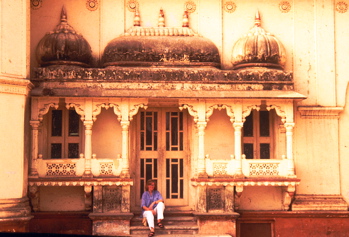
The town of Palanpur has a very vibrant history and is immersed in the local heritage of Gujarat. The town is also surrounded on all sides by mountains and hills from the Aravalli range, and this makes its location very scenic and beautiful. The town is also a very important place for Jains, who have established more than fourteen temples in the town. The seven gates that once guarded the fortified town of Palanpur are now in ruins, and these magnificent structures act as locations of tourist interest now. You can also visit the Keethi Stumbh at Palanpur, which is also known as the Victory Tower. This tower was built during the 1930s. There are many palaces in the town of Palanpur that are must visit places as well, and these are the Balaram palace and the Zorawar Palace.
हिम्मतनगर अम्बाजी

One of the must visit locations in the town of Himmatnagar is the Vaktapur Teerth, which is very famous among pilgrims in and around Gujarat. This temple is located in the highway outside of Himmatnagar, and in the border of the Vaktapur village. The temple is a scenic one that is surrounded by a mango orchard. There are idols of Nakoda Bhairavji, Bhagvan Chintamani Parshwanath and Shri Manibhadravir in the temple.
Yet another pilgrim spot that is famous in the region of Himmatnagar is the Shri Mehsana Teerth. This temple dates back to the 15th century, and is a very ancient temple complex that attracts throngs of devotees from across India. You can also visit the Shamlaji temple, the Akshardham temple in Gandhinagar and the Calico Museum.
Friday, June 8, 2012
Somnath Jyotirlinga Temple

Marvelously adorned Jyotirlinga with flowers, silver and gold adornments is a special attraction in this temple. The aarati puja at this temple is rejuvenating and is best for spiritual enlightenment. Ringing of bells, beating drums and cymbals make the occasion reverberating with Shiv Bhajans.
It is believed that Moon built this temple in Gold, later Ravana renovated it with silver, Lord Krishna by Wood and finally Bhima, one of the Pandavas, built this by stones. The temple had undergone many invasions buy foreign invaders, but still kept it sanctity and prominence. The splendid glory of this temple continues.
The temple was fully renovated and opened for the Somnath devotees in 1995, by the then President of India Shri. Shankar Dayal Sharma. This is a real august specimen of Indian temple architecture and the worthy religious destination to enlighten strong belief in God.
Thursday, June 7, 2012
Junagadh Tourism
 The history of junagadh is chequered by the rules of the Mauryans, Kshatrapas, Guptas, Vilabhis, Chudasamas, Gujarat Sultans and Babi Nawabs. Junagadh, at different times in history, was under the influence of four major religions. Hindu, Bhuddhist, Jain and Muslim. Both political powers and religious influences enriched the culture and created edifices leaving their mark on the architecture of Junagadh.
The history of junagadh is chequered by the rules of the Mauryans, Kshatrapas, Guptas, Vilabhis, Chudasamas, Gujarat Sultans and Babi Nawabs. Junagadh, at different times in history, was under the influence of four major religions. Hindu, Bhuddhist, Jain and Muslim. Both political powers and religious influences enriched the culture and created edifices leaving their mark on the architecture of Junagadh.Junagadh was the capital of the Junagadh State under the Muslim rulers of Babi Nawabs. In Gujarati, `Junagadh' literally means an ancient fort. The junagadh town is located at the foothills the sacred hill of Girnar and occupies a special place in the history of Gujarat.
Jamnagar Surendranagar District
Jamnagar Surendranagar District Tarnetar Fair Swine Flu News Gujarat India

With the fairs and festivities of last week supposedly causing the sudden spurt in cases of H1N1 flu in Saurashtra, Surendranagar district health officials are trying to prevent the spread further in the forthcoming Tarnetar Fair to being on August 22 in the district.
Chief District Health officer of Surendranagar district, Dr BR Solanki said, "We have set up 14 teams for on the spot screening of people who will attend the Tarnetar fair, which will be held 9 km away from Than is ancient Trinetreshwar temple from August 22 to 25."
Anybody suspected of swine flu will be taken to Mahatma Gandhi Hospital in Surendranagar and treated there, Solanki added. More than 5 lakh people are expected to visit this annual festival held at Tarnetar no Melo during the five days.
This apart, across the seven districts of Saurashtra, three of which have already reported positive cases, district health authorities are gearing up to deal with the situation. Seven positive cases have been reported from Rajkot, Jamnagar and Bhavnagar in last two days.
In Rajkot, after a 19-year-old student of Vivekanand Institute of Hotel and Tourism management tested positive, the district health authorities paid a visit to the institute late on Tuesday evening. A team of civil hospital doctors also paid a visit and checked the condition of other students. As two of them showed certain symptoms of the flu, they were sent to civil hospital for precautionary check up.
Ramesh Morani, Chairman of the institute said, "We have taken all necessary steps to be safe. We have asked the students to go home if they wish to and we are also ready to shut the institute if the situation warrants." The total number of suspected cases from Rajkot is now at 19. Four of them have tested positive and nine are negative.
In Jamnagar, of the five suspected cases one has been reported positive, whereas in Bhavnagar both suspected cases are reported positive
District Tarnetar Fair Swine Flu News Gujarat India

With the fairs and festivities of last week supposedly causing the sudden spurt in cases of H1N1 flu in Saurashtra, Surendranagar district health officials are trying to prevent the spread further in the forthcoming Tarnetar Fair to being on August 22 in the district.
Chief District Health officer of Surendranagar district, Dr BR Solanki said, "We have set up 14 teams for on the spot screening of people who will attend the Tarnetar fair, which will be held 9 km away from Than is ancient Trinetreshwar temple from August 22 to 25."
Anybody suspected of swine flu will be taken to Mahatma Gandhi Hospital in Surendranagar and treated there, Solanki added. More than 5 lakh people are expected to visit this annual festival held at Tarnetar no Melo during the five days.
This apart, across the seven districts of Saurashtra, three of which have already reported positive cases, district health authorities are gearing up to deal with the situation. Seven positive cases have been reported from Rajkot, Jamnagar and Bhavnagar in last two days.
In Rajkot, after a 19-year-old student of Vivekanand Institute of Hotel and Tourism management tested positive, the district health authorities paid a visit to the institute late on Tuesday evening. A team of civil hospital doctors also paid a visit and checked the condition of other students. As two of them showed certain symptoms of the flu, they were sent to civil hospital for precautionary check up.
Ramesh Morani, Chairman of the institute said, "We have taken all necessary steps to be safe. We have asked the students to go home if they wish to and we are also ready to shut the institute if the situation warrants." The total number of suspected cases from Rajkot is now at 19. Four of them have tested positive and nine are negative.
In Jamnagar, of the five suspected cases one has been reported positive, whereas in Bhavnagar both suspected cases are reported positive
Wednesday, June 6, 2012
Dwarka Jamnagar
Dwarka Jamnagar Tourism News Gujarat India
The Pune Pravasi Sangh has demanded direct trains to Udaipur, Jamnagar City and Dwarka. The Sangh has also demanded that a direct train to Chennai from Pune instead of Mumbai would benefit passengers in a big way.
These demands were made by Kanubhai Trivedi, president of the Pune Pravasi Sangh Trivedi said the Sangh has a number of plans, especially for long distance travellers. “Besides the electrification of railways, I will be now pressing for the demands of starting direct trains to Udaipur, Jamnagar and Dwarka.
Secondly, all the trains running to Chennai, which make a stop at Pune, come from Mumbai. However, thanks to that, the passengers boarding these trains at Pune station either do not get room, or appear on the waitlist, and thus have to suffer a lot.” Trivedi, a crusader for railway commuter’s rights who turns 81 on Tuesday, said
Nadiad City of Gujarat State
Information
Nadiad is well known for many things. Once upon a time, people like Haridas Biharidas of Nadiad were the flames of public service. The seat of Santaram Maharaj and the Santaram Temple earned fame not only for its religious importance, but for the public service activities also. Nadiad was also the land of laureates and literatures during the later years of l9th century and beginning of the instant. The author of the epic like Gujarati novel 'Saraswatichandra' Govardhanram Tripathi, Mansukhram Shivaram,
Zaverilal Yagnik, Ranchhodbhai Udayram, Manilal Nabhubhai, Balashanker, the poet-painter Phoolchand Master, Rasakavi Raghunath Brahmbhatt were a few of the many literary personalities. The residence of Govardhanram has been preserved like a monument and his statue has been placed in the heart of the town.
Nadiad has developed into a trade centre. There are many hospitals and educational institutions. The Kidney Hospital, Dharmasingh Desai Institute of Technology and the Ayurvedic College are well known throughout.
Nadiad reminds us of a great personality. He was known as pujya Mota. His original name was Chunilal Asharam Bhavsar. Surajba was his mother. For want of economic resources, he could not obtain his higher education after matriculation. Those were the days of Gandhiji. Under the influence and instructions of Gandhiji, he dedicated himself to the service of the nation and to activities for the upliftment of Harijans. He devoted himself to all these activities to such an extent, that he fell seriously ill. The physical misery led him to the notion of committing suicide. But he was saved in one such attempt.















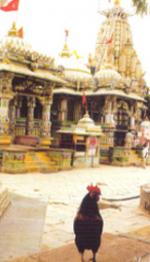
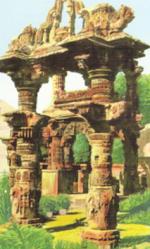
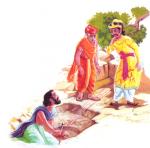
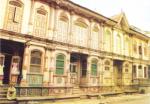
 The Nawab dynasty of Balasinore came to India from Afghanistan and were appointed Subehdars of Ahmedabad during Mughal period. The Garden palace was built in 1883 AD by Nawab Saheb Manover Khanji Babi and is set in fine gardens, agricultural fields and orchards. It has 4 guest rooms, a grand drawing room and beautiful dining hall.
The Nawab dynasty of Balasinore came to India from Afghanistan and were appointed Subehdars of Ahmedabad during Mughal period. The Garden palace was built in 1883 AD by Nawab Saheb Manover Khanji Babi and is set in fine gardens, agricultural fields and orchards. It has 4 guest rooms, a grand drawing room and beautiful dining hall. Location: The Palace Utelia is situated at a distance of 150 kilometers from Baroda, 78 kilometers from Ahmedabad and en route to Bhavnagar. It is a grandiose turn-of-the-century haveli (mansion), which is specially imposing when compared to the hutments that crowd its high walls.
Location: The Palace Utelia is situated at a distance of 150 kilometers from Baroda, 78 kilometers from Ahmedabad and en route to Bhavnagar. It is a grandiose turn-of-the-century haveli (mansion), which is specially imposing when compared to the hutments that crowd its high walls. Beautiful sculptured Jain temples mark the glory of this renowned place. Marked as one of the five holy places for the Jain community, these were created in the 15 the century. During the reign of Rana Kumbha and are enclosed within a wall. The central Chaumukha [four faced temple] is dedicated to Adinathji the temple is an astounding creation with 29 halls and 1,444 pillars all distinctly carved and no two being alike is a amazing evidence of the genius sense of architecture that enhances the charm of the place. Every temple has this conceivable surface carved with equal delicacy. The ambience of Ranakpur is mainly highlighted by the location and the almost divine architecture, giving the same hue as its counter part - the great Dilwara Temple's. in Mt-Abu. Facing the main temple are the unique temples -Parasvanath - Neminath with exquisite figures carving similar to that Khujaraho sculptures. Another temple worth visiting is the nearby 'Sun Temple' dedicated to the 'Sun God' (Surya-the master of all the planets and the provider of light to the whole universe) adorned with polygonal wall, richly embellished with the carvings of warriors, horses and solar (Nakshatras, grahs') deities riding splendid 'chariots' the vehicle of the 'Sun God'- which accordingly to the Hindu Mythology is the God of prosperity and a shining destiny in this world. Many throng this shrine for these blessings. Overall Ranakpur is known as ' The tranquil pilgrimage town'. For the buffs a ride to the outskirts like ' Sadari' - 'Desuri'- 'Ghanerao'- 'Narhai', serves the purpose of their satisfaction.
Beautiful sculptured Jain temples mark the glory of this renowned place. Marked as one of the five holy places for the Jain community, these were created in the 15 the century. During the reign of Rana Kumbha and are enclosed within a wall. The central Chaumukha [four faced temple] is dedicated to Adinathji the temple is an astounding creation with 29 halls and 1,444 pillars all distinctly carved and no two being alike is a amazing evidence of the genius sense of architecture that enhances the charm of the place. Every temple has this conceivable surface carved with equal delicacy. The ambience of Ranakpur is mainly highlighted by the location and the almost divine architecture, giving the same hue as its counter part - the great Dilwara Temple's. in Mt-Abu. Facing the main temple are the unique temples -Parasvanath - Neminath with exquisite figures carving similar to that Khujaraho sculptures. Another temple worth visiting is the nearby 'Sun Temple' dedicated to the 'Sun God' (Surya-the master of all the planets and the provider of light to the whole universe) adorned with polygonal wall, richly embellished with the carvings of warriors, horses and solar (Nakshatras, grahs') deities riding splendid 'chariots' the vehicle of the 'Sun God'- which accordingly to the Hindu Mythology is the God of prosperity and a shining destiny in this world. Many throng this shrine for these blessings. Overall Ranakpur is known as ' The tranquil pilgrimage town'. For the buffs a ride to the outskirts like ' Sadari' - 'Desuri'- 'Ghanerao'- 'Narhai', serves the purpose of their satisfaction. Shanku's provides to all guests high standard services. A visit will convince you that it's a unique water park for fun and adventure for all ages and everybody. The quality and safety of the treated water is of paramount importance to a visitor attraction like this.
Shanku's provides to all guests high standard services. A visit will convince you that it's a unique water park for fun and adventure for all ages and everybody. The quality and safety of the treated water is of paramount importance to a visitor attraction like this.

